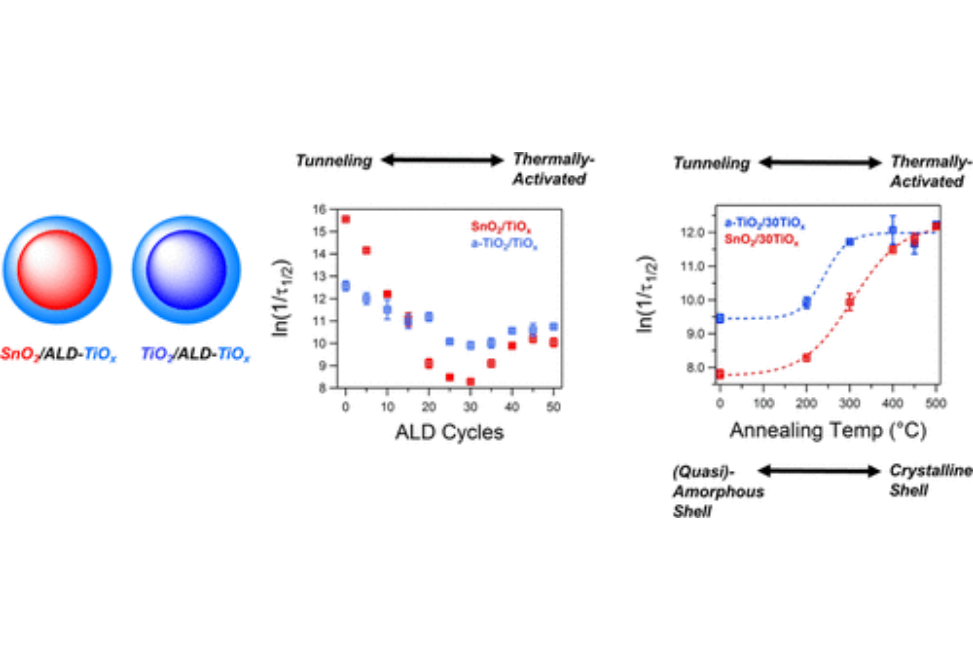Interfacial Electron Transfer through Ultrathin ALD TiOx Layers: A Comparative Study of TiO2/TiOx and SnO2/TiOx Core/Shell Nanocrystals
Abstract
Mesoporous anatase TiO2, mixed anatase/brookite TiO2, and rutile-type SnO2 nanocrystalline films were coated with ultrathin (<5 nm) TiOx by the atomic layer deposition (ALD) of tetrakisdimethylamidotitanium(IV) and water at 150 °C to fabricate SnO2/TiOx and TiO2/TiOx core/shell materials. The core/shell materials were either left as-deposited or underwent a postdeposition heat treatment at varying temperatures. Unsensitized films were characterized by diffuse reflectance, X-ray photoelectron, and Raman spectroscopies in conjunction with high-resolution transmission electron microscopy, powder X-ray diffraction, and reductive electrochemistry. Physical characterization of the unsensitized TiO2/TiOx and SnO2/TiOx films indicates that as-deposited TiOx coatings or those annealed at temperatures <300 °C are disordered and quasi-amorphous, and reductive electrochemistry indicates the presence of a broad distribution of trap states within the band gap. When annealed at temperatures >300 °C, both the physical and electronic structures of the TiOx coatings on TiO2 and SnO2 cores more closely resemble crystalline anatase and rutile TiO2, respectively. Interfacial charge transfer in dye-sensitized [Ru(bpy)2(4,4′-(PO3H2)2bpy)]2+ (bpy = 2,2′-bipyridine; 4,4′-(PO3H2)2bpy = 4,4′-bis(phosphonic acid)-2,2′-bipyridine) core/shell films was investigated using UV–vis, photoluminescence, and transient absorption spectroscopies. Transient absorption experiments demonstrate that charge recombination to the surface-bound, oxidized ruthenium(III) chromophore is intricately connected to the crystallinity of the TiOx coating for both TiO2/TiOx and SnO2/TiOx films. Surprisingly, charge transfer through the as-deposited TiOx coatings and those that were annealed at low temperatures <300 °C on both TiO2 and SnO2 proceeds through a tunneling-type mechanism evidenced by an exponentially decaying charge recombination rate constant with ALD cycles. An inflection from a tunneling-type mechanism to a thermally activated mechanism varies with the shell thickness and the annealing temperature. The results question the validity of fixed rectangular barrier tunneling models frequently used to explain charge recombination in core/shell materials. Instead, a different model is proposed to explain the charge recombination inflection from tunneling to thermally activated as a function of shell thickness and annealing temperature. Finally, the relevance of the findings to devices and the “TiCl4 treatment”, a commonly used method to create TiO2/TiOx core/shell materials to improve the efficiency of dye-sensitized solar cells, is discussed.
Citation
Interfacial Electron Transfer through Ultrathin ALD TiOx Layers: A Comparative Study of TiO2/TiOx and SnO2/TiOx Core/Shell Nanocrystals
Michael J. Mortelliti, Annie N. Wang, and Jillian L. Dempsey
The Journal of Physical Chemistry C 2021 125 (23), 12937-12959
DOI: 10.1021/acs.jpcc.1c02428


